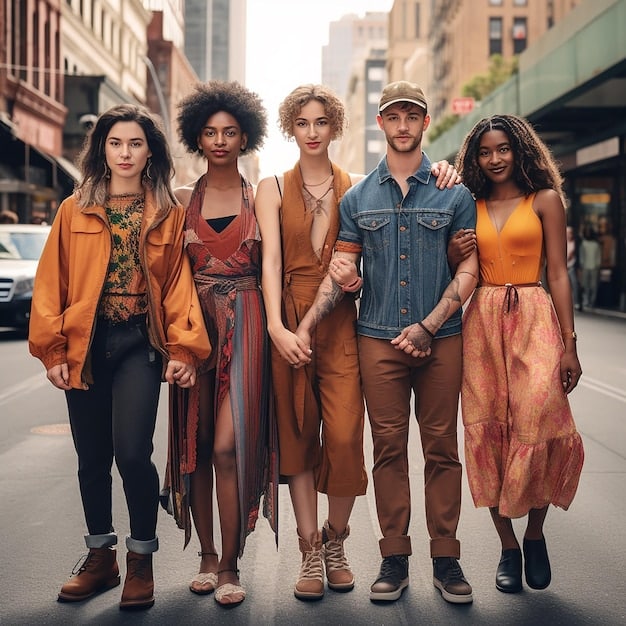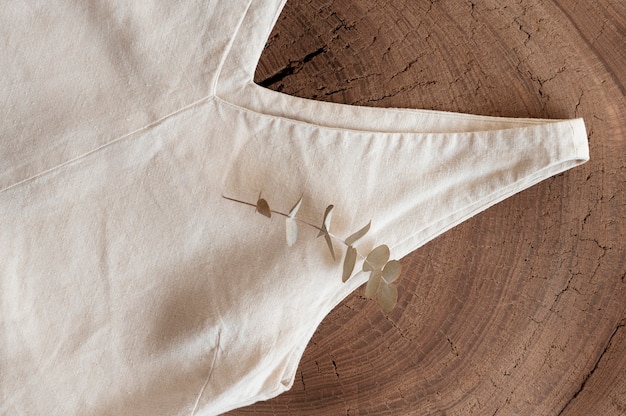Instagram Style Revolution: Sustainable Fashion Feeds Take Over

The Instagram Style Revolution: How Sustainable Fashion is Taking Over Feeds marks a pivotal shift in online fashion, leveraging social media’s power to promote ethical consumption, challenge fast fashion norms, and cultivate a global community valuing conscious style and environmental responsibility.
The landscape of fashion is undergoing a profound transformation, driven not by fleeting trends, but by a rising tide of consciousness. Today, the Instagram Style Revolution: How Sustainable Fashion is Taking Over Feeds is not just a catchy phrase; it’s a tangible movement reshaping how we perceive, consume, and share our style. This paradigm shift underscores a growing collective awareness that extends beyond aesthetics, delving deep into ethical production, environmental impact, and social responsibility.
the rise of conscious fashion on Instagram
Instagram, once synonymous with aspirational luxury and rapid trend cycles, is now a powerful conduit for a quieter, more impactful revolution: sustainable fashion. This platform has democratized the conversation around conscious consumption, allowing independent brands, passionate advocates, and ethical influencers to reach a global audience, fostering a community that prioritizes people and the planet over fleeting trends.
The journey from niche movement to mainstream embrace has been swift, fueled by a growing demographic of consumers who are not only discerning about what they wear but also deeply curious about how it’s made. This shift isn’t just about aesthetics; it’s about ethics, transparency, and a commitment to a better future.
Influencers as educators and advocates
Once seen as mere trendsetters, fashion influencers are evolving into pivotal educators in the sustainable space. They dissect complex supply chains, highlight innovative materials, and champion brands committed to ethical practices, translating abstract concepts into digestible, actionable content for their followers.
- Transparent Storytelling: Influencers often share the behind-the-scenes stories of sustainable brands, showcasing artisan craftsmanship and fair labor practices.
- Myth-Busting: They challenge common misconceptions about sustainable fashion, such as its perceived high cost or limited style options.
- Community Building: Through interactive Q&As, live sessions, and collaborative content, they cultivate engaged communities passionate about ethical style.
The power of visual storytelling
Instagram’s visually-driven nature proves exceptionally suited for showcasing sustainable fashion. Users can see the beauty and versatility of ethically made garments, observe how they integrate into real wardrobes, and appreciate the craftsmanship often lost in mass-produced items. This visual appeal transforms the abstract idea of “sustainability” into something tangible and desirable, making conscious choices more approachable and appealing.
Beyond static images, short-form videos and reels offer dynamic ways to present sustainable fashion. These formats allow creators to share styling tips, demonstrate clothing versatility, and even offer glimpses into the production process, making the sustainable journey feel more personal and relatable.
The curated aesthetic that sustainable fashion brands and advocates bring to Instagram not only catches the eye but also subtly educates. By demonstrating that conscious choices do not equate to sacrificing style, they effectively dismantle the traditional barriers to entry for many consumers.
breaking free from fast fashion’s grip
The dominance of fast fashion, characterized by rapid production cycles, low costs, and disposable trends, has long been a defining feature of the industry. However, the rise of sustainable fashion on Instagram is actively chiseling away at this stronghold, offering a compelling counter-narrative that prioritizes longevity, ethical production, and environmental responsibility.
This challenge to the status quo isn’t just ideological; it’s practical. Sustainable brands, often smaller and more agile, use Instagram to directly connect with consumers who are increasingly disillusioned with the environmental and social costs of throwaway clothing. They present an alternative rooted in intention and quality, rather than endless consumption.

Challenging the trend cycle
Fast fashion thrives on accelerated trend cycles, pushing consumers to constantly update their wardrobes. Sustainable fashion, in direct contrast, promotes a more mindful approach. Instagram creators often advocate for timeless pieces, versatile capsule wardrobes, and creative re-styling of existing garments, directly undermining the need for constant newness.
- Capsule Wardrobes: Influencers showcase how a few high-quality, sustainable pieces can create countless outfits, reducing the urge to buy more.
- Vintage and Secondhand: The platform has become a vibrant marketplace and inspiration hub for vintage and secondhand fashion, promoting circularity.
- Conscious Consumption Challenges: Many ask their followers to participate in “no-buy” or “low-buy” challenges, encouraging thoughtful purchasing habits.
Spotlighting ethical production stories
One of the most impactful ways sustainable fashion challenges fast fashion is by pulling back the curtain on production. Instagram stories, reels, and posts often highlight artisans, fair wage practices, and environmentally sound manufacturing processes, offering a stark contrast to the often opaque supply chains of conventional fashion.
This transparency builds trust and emotional connection between the consumer and the brand. When a customer understands the human and environmental effort behind a garment, its perceived value increases, making them more likely to invest in and cherish it for longer.
By spotlighting these narratives, Instagram helps humanize the production process, turning clothing from a mere commodity into a product of skill, care, and responsible stewardship. This emotional engagement forms a critical barrier against the transient nature of fast fashion.
the community of conscious creators
At the heart of the Instagram phenomenon is its unparalleled ability to foster communities. For sustainable fashion, this has translated into a vibrant ecosystem of creators, brands, and consumers who share common values and actively support each other. This collective energy is driving the conversation forward, promoting best practices, and pushing for systemic change within the industry.
This interconnected network is characterized by shared knowledge, mutual support, and a collective ambition to make fashion a force for good. It’s a space where collaboration often trumps competition, united by a purpose greater than individual gain.
Hashtags as unifying forces
Hashtags like #SustainableFashion, #EthicalStyle, #SlowFashion, and #ConsciousConsumer are more than just labels; they are digital common grounds where millions of posts converge. They allow users to discover new brands, connect with like-minded individuals, and stay abreast of the latest developments in the sustainable fashion sphere, effectively creating searchable, organic directories.
These hashtags serve as powerful discovery tools, enabling content to reach far beyond an individual’s direct followers. They facilitate serendipitous encounters with new ideas, brands, and perspectives that might otherwise remain hidden, thus expanding the reach of the sustainable message organically.
More than just discovery, hashtags foster a sense of belonging. They signify participation in a larger movement, allowing individuals to align their personal values with their online identity and connect with a global tribe.
Collaborations and cross-promotion
The sustainable fashion community on Instagram thrives on collaboration. Influencers partner with ethical brands, brands cross-promote each other’s initiatives, and activists join forces to amplify critical messages. This collaborative spirit strengthens the movement, creating a powerful echo chamber for positive change.
These partnerships often lead to innovative content, reaching diverse audiences and introducing new perspectives. For instance, an upcycling artist might collaborate with a vintage seller, showcasing how their unique talents complement each other to promote circularity in fashion.
- Joint Campaigns: Brands and influencers often launch joint campaigns to raise awareness for specific issues or showcase new sustainable collections.
- Guest Posts and Takeovers: Creators frequently “take over” each other’s accounts, sharing unique insights and expanding their reach.
- Panel Discussions and Live Chats: Online discussions bring together diverse voices, fostering dialogue and deeper understanding among the community.
The democratizing effect of user-generated content
Instagram’s strength lies in its user-generated content (UGC). Everyday individuals, not just celebrities or established influencers, are sharing their sustainable style journeys. This authenticity resonates deeply with audiences, making sustainable fashion feel more accessible and achievable for everyone.
UGC breaks down the elitism often associated with fashion, demonstrating that conscious style is for every body type, every budget, and every personal aesthetic. It empowers individuals to become their own style icons, inspiring others through their personal choices and creativity.
This grassroots approach ensures the movement remains grounded in reality, driven by real people sharing real experiences, which lends immense credibility and relatability to the sustainable fashion narrative.
innovation and creativity in sustainable design
The shift towards sustainable fashion on Instagram is not just about ethical practices; it’s also a hotbed of design innovation and creativity. Designers and brands are pushing boundaries, exploring new materials, revolutionary production methods, and inspiring aesthetics that prove sustainability doesn’t compromise on style or ingenuity.
This creative surge is captivating audiences, demonstrating that conscious choices can lead to truly unique and beautiful garments. It bridges the gap between ethical intent and desirable aesthetics, drawing in consumers who value both.
Exploring alternative materials
One of the most exciting aspects of sustainable fashion showcased on Instagram is the continuous discovery and application of innovative materials. From plant-based leathers to recycled synthetics, these alternatives offer eco-friendly options that challenge traditional textile production.
- Mushroom Leather: Brands are experimenting with mycelium-based materials that offer a biodegradable and cruelty-free alternative to animal leather.
- Recycled Ocean Plastics: Yarns made from recovered ocean plastics are being transformed into activewear and swimwear, cleaning up the environment while creating new products.
- Hemp and Organic Cotton: These traditional fibers are gaining renewed attention for their minimal environmental impact compared to conventional cotton.
Showcasing these materials on Instagram allows brands to highlight their unique textures, durability, and origins, educating consumers about the science and nature behind their clothing.
Upcycling and repurposing
Upcycling and repurposing old garments into new, fashionable pieces have found a perfect home on Instagram. Designers and DIY enthusiasts share their transformations, inspiring followers to extend the life of their clothes and reduce textile waste. This creative expression celebrates individuality and resourcefulness.
The visual nature of Instagram is ideal for “before and after” transformations, making the appeal of upcycling immediately evident. It turns what was once considered waste into a canvas for imaginative design, sparking a whole sub-movement within sustainable fashion.
Platforms like Depop and Poshmark have leveraged Instagram’s visual power, allowing individuals to easily sell and buy pre-loved clothes, fostering a circular economy where garments find new homes rather than landfills.
Circular design principles
Sustainable fashion on Instagram is actively promoting the principles of circular design, where garments are designed for longevity, repairability, and eventual recycling or biodegradability. This holistic approach aims to eliminate waste and pollution from the outset, rather than trying to manage it at the end of a product’s life cycle.
Brands use Instagram to explain their take-back programs, repair services, and initiatives that encourage customers to return old items for recycling, effectively closing the loop on textile waste. This forward-thinking approach appeals to highly informed and environmentally conscious consumers.
By transparently sharing their commitment to circularity, brands build immense trust and loyalty, setting a new standard for responsibility in the fashion industry.
the future of fashion: a sustainable feed
The trajectory of fashion on Instagram points towards an increasingly sustainable future. What began as a ripple is now a significant wave, reshaping consumer expectations, industry practices, and even the platform’s own content strategies. The continuous growth of conscious consumption movements indicates that sustainability is not a trend, but a fundamental shift.
As Instagram continues to evolve, its role in accelerating this transformation will only grow, serving as a vital nexus for innovation, community, and consumer education within the fashion realm.
Mainstreaming ethical choices
The relentless visibility of sustainable fashion on Instagram is slowly but surely normalizing ethical choices. As more influencers, brands, and everyday users showcase conscious consumption, it becomes less of a niche interest and more of an expected standard. This widespread exposure is critical for mass adoption.
The platform acts as a powerful peer-to-peer influence mechanism. When friends and trusted figures on Instagram make sustainable choices, it creates a ripple effect, encouraging others to follow suit and explore similar options in their own purchasing habits.
Retailers are also tuning in. Many major brands are beginning to feature sustainable collections more prominently on their feeds, indicating that the market is responding to consumer demand driven in part by Instagram’s influence.

Policy and industry pressure
The discussions and movements originating on Instagram are not confined to the digital sphere; they are increasingly influencing industry policies and corporate behavior. Consumer demand amplified on social media is putting pressure on large corporations to re-evaluate their supply chains and environmental impact.
- Brand Accountability: Consumers are using Instagram to demand greater transparency from brands regarding their labor practices and environmental footprint.
- Greenwashing Awareness: The community on Instagram is adept at identifying and calling out “greenwashing,” holding brands accountable for misleading claims.
- Advocacy for Legislation: Influencers and organizations use the platform to advocate for stronger governmental regulations and industry standards in fashion.
This amplified consumer voice is creating a feedback loop where social pressure informs business decisions, driving a positive cycle of continuous improvement in sustainability.
The educational imperative
As sustainable fashion becomes more complex, involving detailed discussions about certifications, materials, and ethical labor, Instagram’s role as an educational tool becomes even more vital. Simplified, visually engaging content helps breakdown complex topics into understandable formats, empowering consumers to make truly informed decisions.
Without easily accessible information, greenwashing can thrive. Instagram’s ability to disseminate clear, concise, and verifiable information helps equip consumers with the knowledge needed to navigate the nuances of truly sustainable choices versus mere marketing ploys.
The visual nature of the platform also supports learning by showing. For example, a post illustrating the difference between organic and conventional cotton can be far more impactful than a lengthy, text-based explanation.
challenges and considerations for the movement
While the Instagram Style Revolution for sustainable fashion is undeniably powerful, it is not without its challenges. Navigating issues like greenwashing, accessibility, and the inherent consumerism of the platform itself requires continuous vigilance and thoughtful engagement from all stakeholders.
Addressing these complexities is crucial for the movement to maintain its integrity, expand its reach, and achieve its ultimate goal of transforming the global fashion industry for the better. These aren’t roadblocks, but rather opportunities for growth and refinement.
The ongoing battle against greenwashing
One of the most persistent challenges is greenwashing, where brands present themselves as environmentally friendly without genuinely adopting sustainable practices. Instagram, while a powerful tool for transparency, can also be misused for superficial marketing claims that mislead consumers.
The community needs to remain discerning, relying on credible sources, certifications, and in-depth research rather than just appealing visuals. Education is the best defense against deceptive practices.
Identifying greenwashing often involves looking beyond surface-level claims and scrutinizing a brand’s entire supply chain, from raw materials to labor conditions. This deep dive is often facilitated by informed influencers and watchdog accounts on Instagram.
Accessibility and affordability
Sustainable fashion can often come with a higher price tag due to ethical labor costs, innovative materials, and smaller production runs. This poses an ongoing challenge for making conscious choices universally accessible, particularly for lower-income consumers.
- Vintage and Secondhand Markets: These are crucial for making sustainable fashion more affordable and inclusive.
- DIY and Repair: Encouraging skill-building for mending and creating can reduce financial barriers.
- Cost-Per-Wear Analysis: Educating consumers on the long-term value of durable, well-made garments often outweighs the initial higher cost.
The conversation on Instagram needs to continually emphasize that sustainable fashion isn’t solely about buying new, expensive items, but about extending the life of what we already own and valuing quality over quantity.
The paradox of consumption on a consumer platform
Instagram inherently promotes consumption, regardless of the product. The challenge for sustainable fashion advocates is to encourage conscious consumption—buying less, buying better, and valuing longevity—within a platform that thrives on visual newness and aspirational lifestyles.
This paradox requires a nuanced approach where creators focus on inspiring mindful choices rather than simply showcasing new products. It emphasizes storytelling around longevity, versatility, and the joy of owning fewer, cherished items.
Successful sustainable accounts often shift the focus from “what to buy” to “how to live sustainably,” integrating fashion into a broader lifestyle choice that promotes reduced environmental impact and deeper personal values.
measuring impact and looking ahead
Measuring the true impact of the sustainable fashion movement on Instagram goes beyond likes and follower counts. It involves tracking shifts in consumer behavior, brand accountability, and the broader industry’s embrace of ethical practices. While quantifying exact figures remains complex, qualitative evidence points overwhelmingly to a transformative effect.
The change is evident in the narratives brands adopt, the investments being made in sustainable technologies, and the growing demand for transparency across the fashion ecosystem. Instagram is not merely reflecting these changes; it is actively catalyzing them.
Shifting consumer behaviors
The most significant impact is seen in the evolving mindset of consumers. An increasing number of individuals, influenced by content on Instagram, are actively seeking out sustainable brands, participating in clothing swaps, embracing secondhand shopping, and demanding greater transparency from their favorite labels.
This shift from passive consumption to active, informed purchasing is a powerful indicator of the lasting influence of the Instagram movement. Consumers are becoming advocates, using their purchasing power to vote for a better fashion future.
The rise of digital thrift stores and peer-to-peer selling platforms, heavily promoted and utilized on Instagram, further solidifies this behavioral change towards circularity.
Industry response and adaptations
Major fashion retailers and luxury brands, initially slow to respond, are now integrating sustainable practices and collections into their core strategies. This adaptation is a direct result of sustained consumer pressure and the undeniable rise of sustainable fashion’s visibility on platforms like Instagram.
- Dedicated Sustainable Lines: Many brands now offer specific collections made from recycled or organic materials.
- Transparency Reports: Publicly available reports detailing supply chains and environmental metrics are becoming more common.
- Investment in Sustainable Technology: Brands are funding research into innovative materials and production processes.
This top-down response indicates that sustainability is no longer a niche concern but a strategic imperative that will shape the industry for decades to come.
The role of technology in future sustainability
As technology advances, so too will the possibilities for sustainable fashion, and Instagram will continue to be a key platform for sharing these innovations. From AI-driven solutions for waste reduction to blockchain for supply chain transparency, the future promises even more sophisticated tools for fostering a truly sustainable industry.
Instagram’s ability to amplify these technological advancements will be crucial for widespread adoption. By visually demonstrating how tech can solve environmental problems, it makes complex solutions tangible and relatable to a mass audience.
The platform also offers a space for open innovation, allowing startups and established companies to share their progress, gather feedback, and collaborate on solutions that accelerate the transition to a more ethical and ecological fashion system.
| Key Aspect | Brief Description |
|---|---|
| 🌱 Influencer Evolution | Influencers now educate on ethical production, materials, and conscious consumption, moving beyond just showcasing trends. |
| 🔄 Circular Economy | Instagram promotes secondhand, vintage, and upcycling, challenging fast fashion’s linear take-make-dispose model. |
| 💡 Material Innovation | The platform highlights new eco-friendly fabrics and design principles, proving sustainability is stylish. |
| 🌍 Industry Pressure | Consumer demand from Instagram influences major brands to adopt more ethical and transparent practices. |
frequently asked questions
▼
Sustainable fashion emphasizes environmental consciousness and social responsibility throughout the product lifecycle. It includes using eco-friendly materials, ensuring ethical labor practices, promoting longevity, and designing for circularity to minimize waste and pollution.
▼
Instagram serves as a powerful platform for awareness and advocacy. It allows sustainable brands to connect directly with consumers, influencers to educate on ethical choices, and a global community to share and promote conscious consumption habits, democratizing the movement.
▼
Greenwashing refers to marketing practices where brands misleadingly portray themselves as environmentally friendly, often without substantial evidence or genuine commitment. On Instagram, it can involve vague claims or showcasing one small eco-friendly initiative while core practices remain unsustainable.
▼
Yes, sustainable fashion can be affordable, especially through avenues like secondhand shopping, vintage finds, and clothing swaps. While new ethically produced items might have a higher upfront cost, their durability and longevity often provide better value over time compared to fast fashion items.
▼
Influencers are crucial educators and advocates. They simplify complex topics, introduce sustainable brands, share styling tips for conscious wardrobes, and build communities that prioritize ethical choices, making the movement relatable and accessible to a wider audience on Instagram.
conclusion
The Instagram Style Revolution is far more than just a trend—it’s a potent force reshaping the fashion industry from the inside out. By leveraging its visual appeal and community-building power, Instagram has transformed into a vital platform for sustainable fashion, proving that style, ethics, and environmental responsibility can coexist and thrive. As awareness grows and technology advances, this revolution will undoubtedly continue to inspire meaningful change, fostering a future where conscious consumption is not an alternative, but the prevailing norm.





